Report: Application of Decision-Making Concepts at Woolworths
VerifiedAdded on 2020/04/01
|10
|1890
|44
Report
AI Summary
This report examines decision-making concepts, primarily focusing on Herbert Simon's theories, and applies them to case studies of Woolworths, an Australian retail organization. The report analyzes three specific instances where Woolworths' decisions, including the Homebrand strategy, the Masters hardware venture, and other strategic choices, led to negative outcomes or exhibited biases. It relates these scenarios to Simon's concepts of judgment and decision-making, system 1 and 2 thinking, and bounded rationality, highlighting how cognitive limitations, emotional influences, and external factors impacted the decision-making processes. The report provides detailed explanations of each case, identifying the flaws in judgment and the application of inappropriate decision-making systems. Furthermore, it suggests potential solutions and strategies Woolworths could have employed to mitigate the negative consequences of their decisions, emphasizing the importance of market research, strategic planning, and a balanced approach to decision-making for business success.
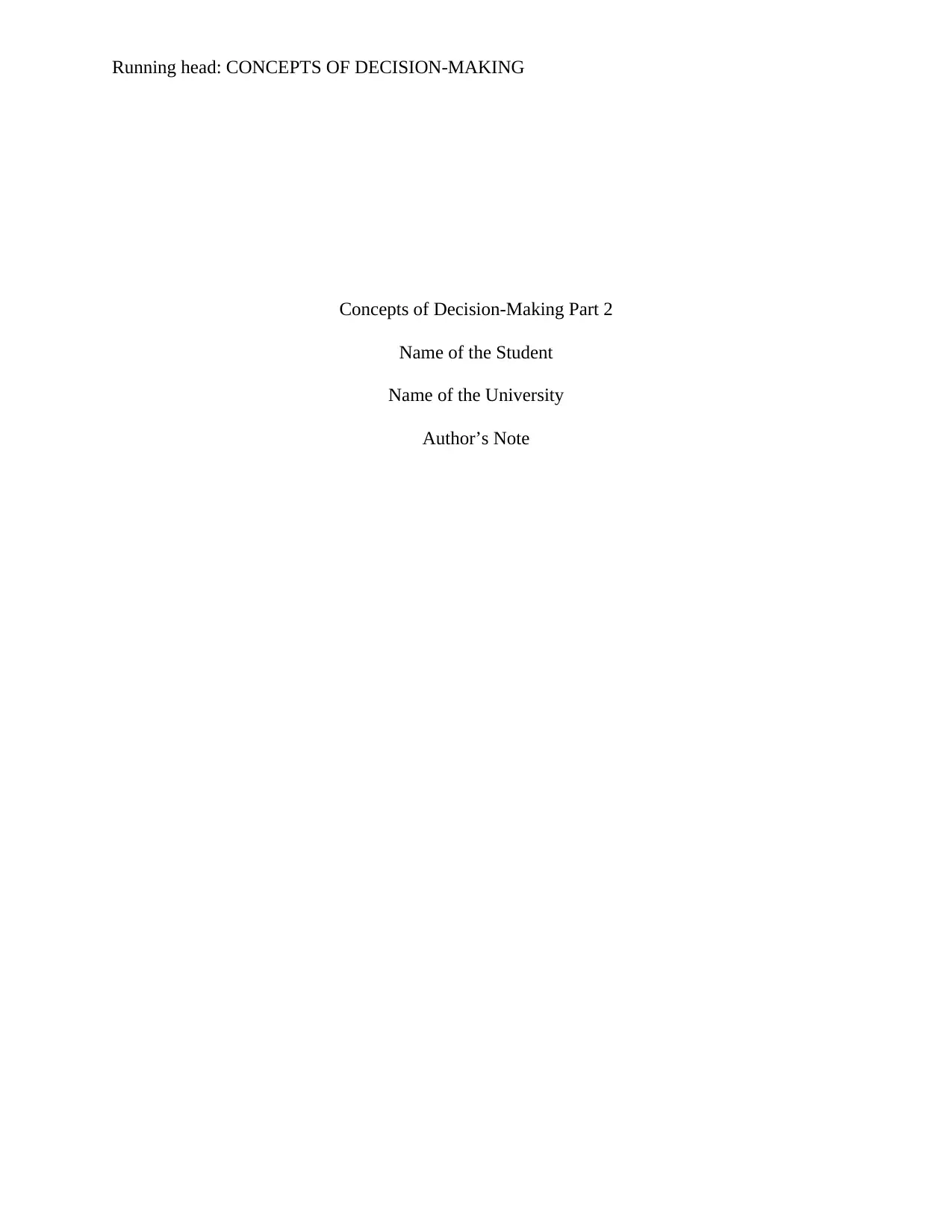
Running head: CONCEPTS OF DECISION-MAKING
Concepts of Decision-Making Part 2
Name of the Student
Name of the University
Author’s Note
Concepts of Decision-Making Part 2
Name of the Student
Name of the University
Author’s Note
Paraphrase This Document
Need a fresh take? Get an instant paraphrase of this document with our AI Paraphraser
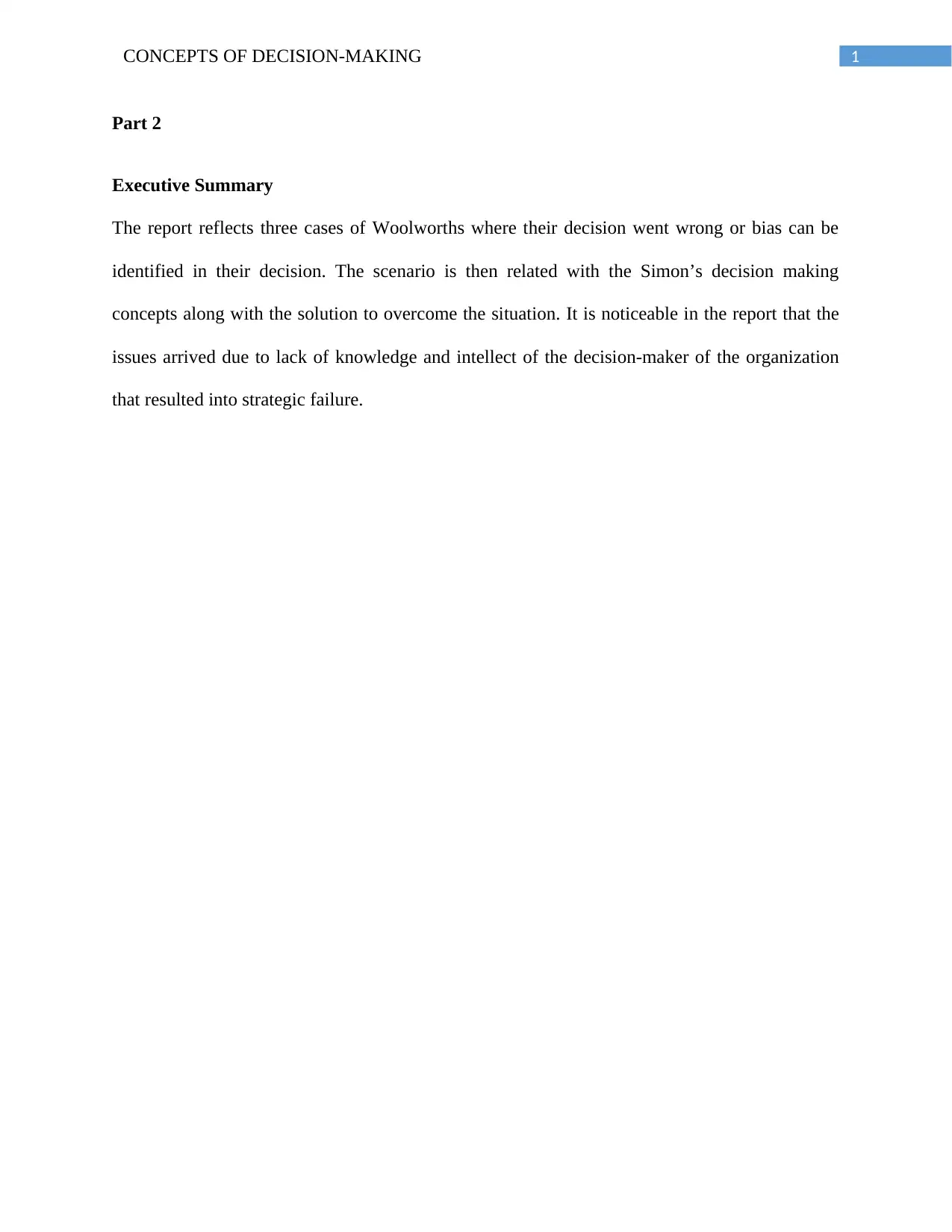
1CONCEPTS OF DECISION-MAKING
Part 2
Executive Summary
The report reflects three cases of Woolworths where their decision went wrong or bias can be
identified in their decision. The scenario is then related with the Simon’s decision making
concepts along with the solution to overcome the situation. It is noticeable in the report that the
issues arrived due to lack of knowledge and intellect of the decision-maker of the organization
that resulted into strategic failure.
Part 2
Executive Summary
The report reflects three cases of Woolworths where their decision went wrong or bias can be
identified in their decision. The scenario is then related with the Simon’s decision making
concepts along with the solution to overcome the situation. It is noticeable in the report that the
issues arrived due to lack of knowledge and intellect of the decision-maker of the organization
that resulted into strategic failure.
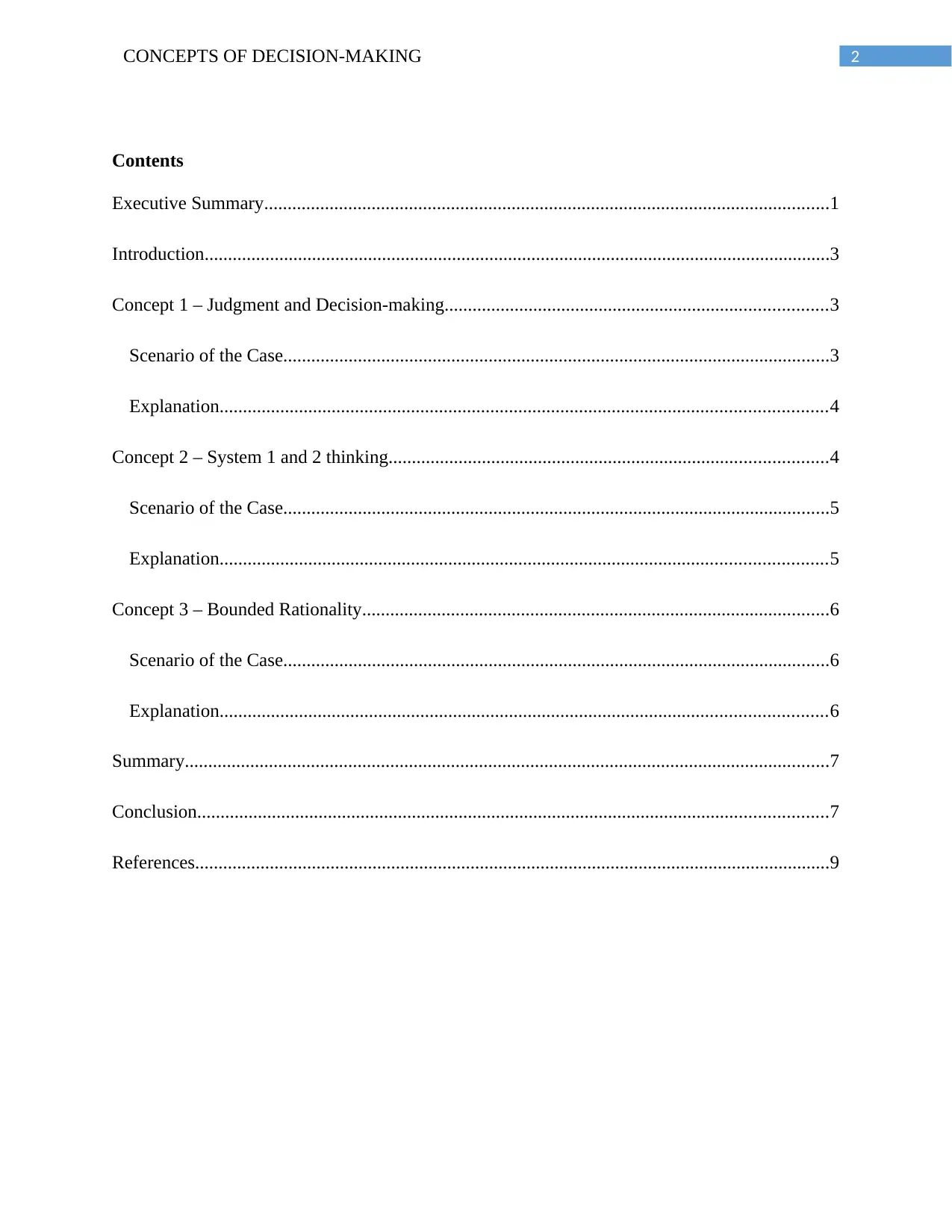
2CONCEPTS OF DECISION-MAKING
Contents
Executive Summary.........................................................................................................................1
Introduction......................................................................................................................................3
Concept 1 – Judgment and Decision-making..................................................................................3
Scenario of the Case.....................................................................................................................3
Explanation..................................................................................................................................4
Concept 2 – System 1 and 2 thinking..............................................................................................4
Scenario of the Case.....................................................................................................................5
Explanation..................................................................................................................................5
Concept 3 – Bounded Rationality....................................................................................................6
Scenario of the Case.....................................................................................................................6
Explanation..................................................................................................................................6
Summary..........................................................................................................................................7
Conclusion.......................................................................................................................................7
References........................................................................................................................................9
Contents
Executive Summary.........................................................................................................................1
Introduction......................................................................................................................................3
Concept 1 – Judgment and Decision-making..................................................................................3
Scenario of the Case.....................................................................................................................3
Explanation..................................................................................................................................4
Concept 2 – System 1 and 2 thinking..............................................................................................4
Scenario of the Case.....................................................................................................................5
Explanation..................................................................................................................................5
Concept 3 – Bounded Rationality....................................................................................................6
Scenario of the Case.....................................................................................................................6
Explanation..................................................................................................................................6
Summary..........................................................................................................................................7
Conclusion.......................................................................................................................................7
References........................................................................................................................................9
⊘ This is a preview!⊘
Do you want full access?
Subscribe today to unlock all pages.

Trusted by 1+ million students worldwide

3CONCEPTS OF DECISION-MAKING
Introduction
Simon is one of the pioneers in the field of theories of decision-making. He received
Nobel Prize in the year 1978 for his work. He proposed three activities in decision making that
are intelligence gathering, design, and choice. However, his model of decision-making is only
valid in the ideal world where external factors does not influence the decision making process. In
case of real world decision-making, several external factors like time, cost, preferences and many
more influence the decision taken by the decision-makers. This report identifies the case of
Woolworths, an Australian retail organization. Many of their decisions could be marked as
biased and irrational. Some of the decisions of the company have been identify in the report. An
analyzed in relation to the concepts discussed in the previous assignment is made with the case in
hand. Brief description of the scenario is provided in the report. A brief summary of the
discussion is focusing on the importance for the management in decision-making.
Concept 1 – Judgment and Decision-making
The judgment and decision-making are supposed to be bounded by rationality as per
Simon’s theory of decision-making. However, various cognitive limitations of human lead them
to take biased decision in the real world application (Gilovich & Griffin, 2010).
Scenario of the Case
Homebrand is a private brand in Woolworths that will provide the household utensils in a
cheaper rate than usual Woolworths’ pricing. It is to target the lower income group of the target
market. Homebrand is made available in every store of Woolworths around the country. This
Introduction
Simon is one of the pioneers in the field of theories of decision-making. He received
Nobel Prize in the year 1978 for his work. He proposed three activities in decision making that
are intelligence gathering, design, and choice. However, his model of decision-making is only
valid in the ideal world where external factors does not influence the decision making process. In
case of real world decision-making, several external factors like time, cost, preferences and many
more influence the decision taken by the decision-makers. This report identifies the case of
Woolworths, an Australian retail organization. Many of their decisions could be marked as
biased and irrational. Some of the decisions of the company have been identify in the report. An
analyzed in relation to the concepts discussed in the previous assignment is made with the case in
hand. Brief description of the scenario is provided in the report. A brief summary of the
discussion is focusing on the importance for the management in decision-making.
Concept 1 – Judgment and Decision-making
The judgment and decision-making are supposed to be bounded by rationality as per
Simon’s theory of decision-making. However, various cognitive limitations of human lead them
to take biased decision in the real world application (Gilovich & Griffin, 2010).
Scenario of the Case
Homebrand is a private brand in Woolworths that will provide the household utensils in a
cheaper rate than usual Woolworths’ pricing. It is to target the lower income group of the target
market. Homebrand is made available in every store of Woolworths around the country. This
Paraphrase This Document
Need a fresh take? Get an instant paraphrase of this document with our AI Paraphraser

4CONCEPTS OF DECISION-MAKING
decision of the organization might have some potential impact on the overall organization as it
deviates from the actual strategy of the organization.
Explanation
The judgment of the company is taken in a bias cognitive mindset of the higher authority
of the company. Company seeks to target the larger target population with this lower cost brand.
It clearly deviates from the organization’s actual marketing strategy that provides high quality
product for a comparatively higher rate. Their vision is that, lower price will drop the products
value in the market. Currently, Homebrand is providing high quality product in a comparatively
low rate that will hamper the sale of the high-end products of the company. The higher income
group will also lean towards Homebrand as they are getting satisfactory quality in a considerable
low price. It will lead to failure of Woolworths’ primary strategy. The Homebrand strategy was
taken by the organization to compete the other supermarkets in the target market.
The decision-makers of Woolworths should consider revising their decision and strategy
implemented for Homebrand. They need to distinguish the Homebrand products from the main
product line of the organization. As they have already started providing the products in a
comparatively low price, they cannot change the decision. However, they can make strategies for
overcoming their wrong judgment. Two possible ways could be identify to overcome the
situation. They can either decrease the quality or decrease the quantity. However, to avoid any
issues that might occur regarding this decision, they can go for both. A minimal decrease in
quality and quantity will hardly make any impact on the product; however will considerably
decrease the costing of the product and increase the profit of the company.
decision of the organization might have some potential impact on the overall organization as it
deviates from the actual strategy of the organization.
Explanation
The judgment of the company is taken in a bias cognitive mindset of the higher authority
of the company. Company seeks to target the larger target population with this lower cost brand.
It clearly deviates from the organization’s actual marketing strategy that provides high quality
product for a comparatively higher rate. Their vision is that, lower price will drop the products
value in the market. Currently, Homebrand is providing high quality product in a comparatively
low rate that will hamper the sale of the high-end products of the company. The higher income
group will also lean towards Homebrand as they are getting satisfactory quality in a considerable
low price. It will lead to failure of Woolworths’ primary strategy. The Homebrand strategy was
taken by the organization to compete the other supermarkets in the target market.
The decision-makers of Woolworths should consider revising their decision and strategy
implemented for Homebrand. They need to distinguish the Homebrand products from the main
product line of the organization. As they have already started providing the products in a
comparatively low price, they cannot change the decision. However, they can make strategies for
overcoming their wrong judgment. Two possible ways could be identify to overcome the
situation. They can either decrease the quality or decrease the quantity. However, to avoid any
issues that might occur regarding this decision, they can go for both. A minimal decrease in
quality and quantity will hardly make any impact on the product; however will considerably
decrease the costing of the product and increase the profit of the company.
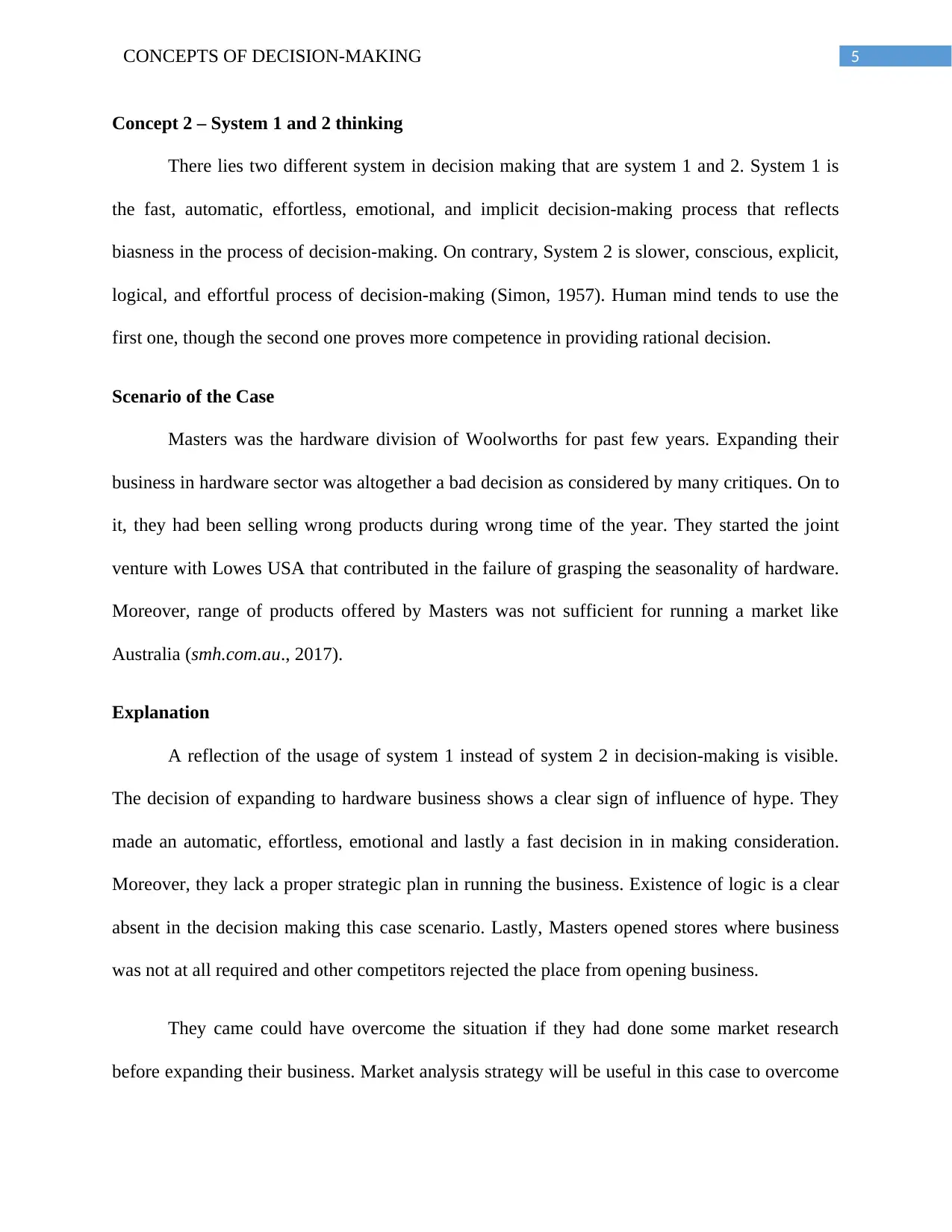
5CONCEPTS OF DECISION-MAKING
Concept 2 – System 1 and 2 thinking
There lies two different system in decision making that are system 1 and 2. System 1 is
the fast, automatic, effortless, emotional, and implicit decision-making process that reflects
biasness in the process of decision-making. On contrary, System 2 is slower, conscious, explicit,
logical, and effortful process of decision-making (Simon, 1957). Human mind tends to use the
first one, though the second one proves more competence in providing rational decision.
Scenario of the Case
Masters was the hardware division of Woolworths for past few years. Expanding their
business in hardware sector was altogether a bad decision as considered by many critiques. On to
it, they had been selling wrong products during wrong time of the year. They started the joint
venture with Lowes USA that contributed in the failure of grasping the seasonality of hardware.
Moreover, range of products offered by Masters was not sufficient for running a market like
Australia (smh.com.au., 2017).
Explanation
A reflection of the usage of system 1 instead of system 2 in decision-making is visible.
The decision of expanding to hardware business shows a clear sign of influence of hype. They
made an automatic, effortless, emotional and lastly a fast decision in in making consideration.
Moreover, they lack a proper strategic plan in running the business. Existence of logic is a clear
absent in the decision making this case scenario. Lastly, Masters opened stores where business
was not at all required and other competitors rejected the place from opening business.
They came could have overcome the situation if they had done some market research
before expanding their business. Market analysis strategy will be useful in this case to overcome
Concept 2 – System 1 and 2 thinking
There lies two different system in decision making that are system 1 and 2. System 1 is
the fast, automatic, effortless, emotional, and implicit decision-making process that reflects
biasness in the process of decision-making. On contrary, System 2 is slower, conscious, explicit,
logical, and effortful process of decision-making (Simon, 1957). Human mind tends to use the
first one, though the second one proves more competence in providing rational decision.
Scenario of the Case
Masters was the hardware division of Woolworths for past few years. Expanding their
business in hardware sector was altogether a bad decision as considered by many critiques. On to
it, they had been selling wrong products during wrong time of the year. They started the joint
venture with Lowes USA that contributed in the failure of grasping the seasonality of hardware.
Moreover, range of products offered by Masters was not sufficient for running a market like
Australia (smh.com.au., 2017).
Explanation
A reflection of the usage of system 1 instead of system 2 in decision-making is visible.
The decision of expanding to hardware business shows a clear sign of influence of hype. They
made an automatic, effortless, emotional and lastly a fast decision in in making consideration.
Moreover, they lack a proper strategic plan in running the business. Existence of logic is a clear
absent in the decision making this case scenario. Lastly, Masters opened stores where business
was not at all required and other competitors rejected the place from opening business.
They came could have overcome the situation if they had done some market research
before expanding their business. Market analysis strategy will be useful in this case to overcome
⊘ This is a preview!⊘
Do you want full access?
Subscribe today to unlock all pages.

Trusted by 1+ million students worldwide
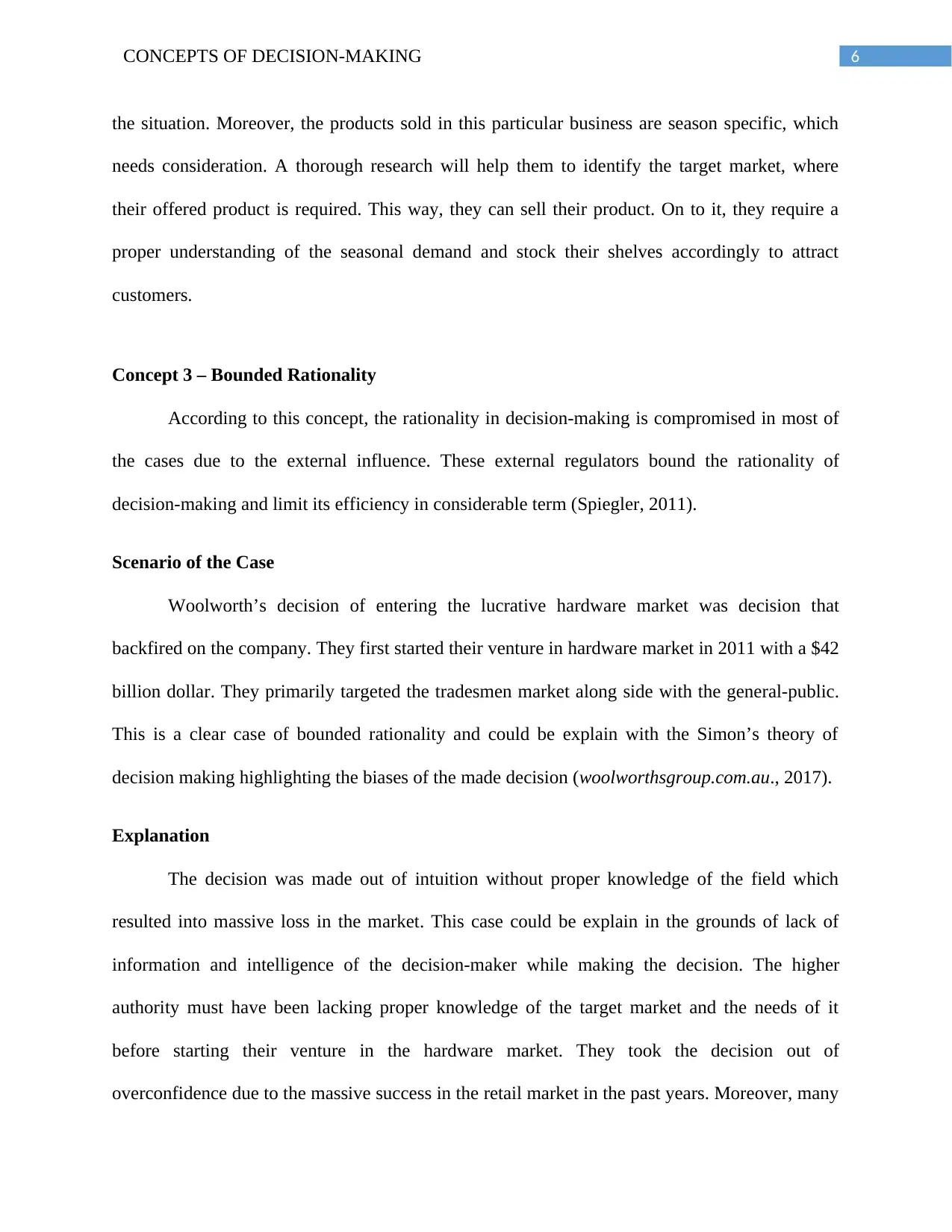
6CONCEPTS OF DECISION-MAKING
the situation. Moreover, the products sold in this particular business are season specific, which
needs consideration. A thorough research will help them to identify the target market, where
their offered product is required. This way, they can sell their product. On to it, they require a
proper understanding of the seasonal demand and stock their shelves accordingly to attract
customers.
Concept 3 – Bounded Rationality
According to this concept, the rationality in decision-making is compromised in most of
the cases due to the external influence. These external regulators bound the rationality of
decision-making and limit its efficiency in considerable term (Spiegler, 2011).
Scenario of the Case
Woolworth’s decision of entering the lucrative hardware market was decision that
backfired on the company. They first started their venture in hardware market in 2011 with a $42
billion dollar. They primarily targeted the tradesmen market along side with the general-public.
This is a clear case of bounded rationality and could be explain with the Simon’s theory of
decision making highlighting the biases of the made decision (woolworthsgroup.com.au., 2017).
Explanation
The decision was made out of intuition without proper knowledge of the field which
resulted into massive loss in the market. This case could be explain in the grounds of lack of
information and intelligence of the decision-maker while making the decision. The higher
authority must have been lacking proper knowledge of the target market and the needs of it
before starting their venture in the hardware market. They took the decision out of
overconfidence due to the massive success in the retail market in the past years. Moreover, many
the situation. Moreover, the products sold in this particular business are season specific, which
needs consideration. A thorough research will help them to identify the target market, where
their offered product is required. This way, they can sell their product. On to it, they require a
proper understanding of the seasonal demand and stock their shelves accordingly to attract
customers.
Concept 3 – Bounded Rationality
According to this concept, the rationality in decision-making is compromised in most of
the cases due to the external influence. These external regulators bound the rationality of
decision-making and limit its efficiency in considerable term (Spiegler, 2011).
Scenario of the Case
Woolworth’s decision of entering the lucrative hardware market was decision that
backfired on the company. They first started their venture in hardware market in 2011 with a $42
billion dollar. They primarily targeted the tradesmen market along side with the general-public.
This is a clear case of bounded rationality and could be explain with the Simon’s theory of
decision making highlighting the biases of the made decision (woolworthsgroup.com.au., 2017).
Explanation
The decision was made out of intuition without proper knowledge of the field which
resulted into massive loss in the market. This case could be explain in the grounds of lack of
information and intelligence of the decision-maker while making the decision. The higher
authority must have been lacking proper knowledge of the target market and the needs of it
before starting their venture in the hardware market. They took the decision out of
overconfidence due to the massive success in the retail market in the past years. Moreover, many
Paraphrase This Document
Need a fresh take? Get an instant paraphrase of this document with our AI Paraphraser
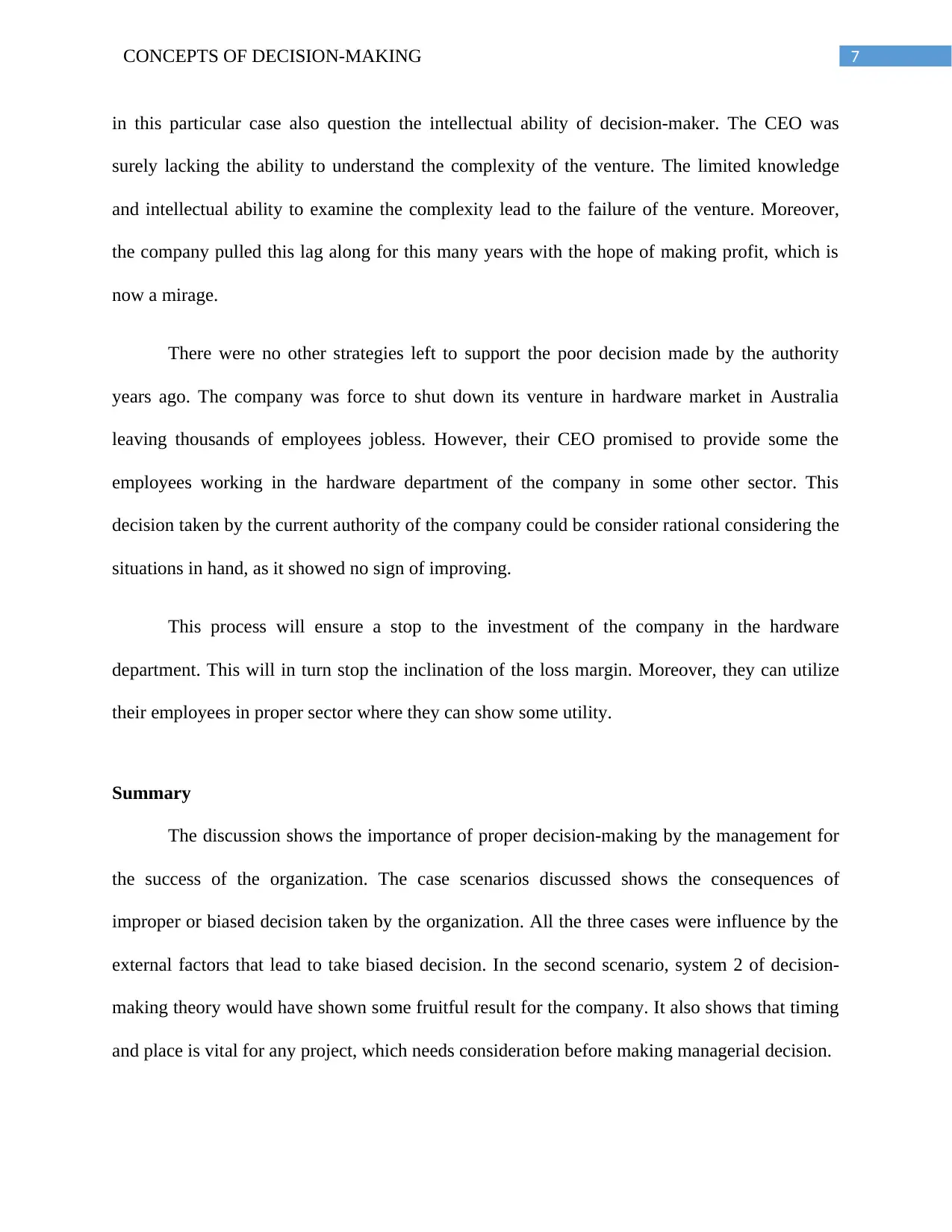
7CONCEPTS OF DECISION-MAKING
in this particular case also question the intellectual ability of decision-maker. The CEO was
surely lacking the ability to understand the complexity of the venture. The limited knowledge
and intellectual ability to examine the complexity lead to the failure of the venture. Moreover,
the company pulled this lag along for this many years with the hope of making profit, which is
now a mirage.
There were no other strategies left to support the poor decision made by the authority
years ago. The company was force to shut down its venture in hardware market in Australia
leaving thousands of employees jobless. However, their CEO promised to provide some the
employees working in the hardware department of the company in some other sector. This
decision taken by the current authority of the company could be consider rational considering the
situations in hand, as it showed no sign of improving.
This process will ensure a stop to the investment of the company in the hardware
department. This will in turn stop the inclination of the loss margin. Moreover, they can utilize
their employees in proper sector where they can show some utility.
Summary
The discussion shows the importance of proper decision-making by the management for
the success of the organization. The case scenarios discussed shows the consequences of
improper or biased decision taken by the organization. All the three cases were influence by the
external factors that lead to take biased decision. In the second scenario, system 2 of decision-
making theory would have shown some fruitful result for the company. It also shows that timing
and place is vital for any project, which needs consideration before making managerial decision.
in this particular case also question the intellectual ability of decision-maker. The CEO was
surely lacking the ability to understand the complexity of the venture. The limited knowledge
and intellectual ability to examine the complexity lead to the failure of the venture. Moreover,
the company pulled this lag along for this many years with the hope of making profit, which is
now a mirage.
There were no other strategies left to support the poor decision made by the authority
years ago. The company was force to shut down its venture in hardware market in Australia
leaving thousands of employees jobless. However, their CEO promised to provide some the
employees working in the hardware department of the company in some other sector. This
decision taken by the current authority of the company could be consider rational considering the
situations in hand, as it showed no sign of improving.
This process will ensure a stop to the investment of the company in the hardware
department. This will in turn stop the inclination of the loss margin. Moreover, they can utilize
their employees in proper sector where they can show some utility.
Summary
The discussion shows the importance of proper decision-making by the management for
the success of the organization. The case scenarios discussed shows the consequences of
improper or biased decision taken by the organization. All the three cases were influence by the
external factors that lead to take biased decision. In the second scenario, system 2 of decision-
making theory would have shown some fruitful result for the company. It also shows that timing
and place is vital for any project, which needs consideration before making managerial decision.

8CONCEPTS OF DECISION-MAKING
Conclusion
The above discussion identified three different concept of decision-making as proposed
by Simon in his work. The brief discussion helped in understanding the concept. The concepts
were support with the real word examples of Woolworths where the consequence of biased
decision highlighted. Moreover, the strategy required to overcome the situation is also stated in
the scenarios. One can see how the company’s decision with limited knowledge over market
affected their failure in the hardware market. Moreover, the first scenario shows those threats of
making false decision and the process of overcoming the situation.
Conclusion
The above discussion identified three different concept of decision-making as proposed
by Simon in his work. The brief discussion helped in understanding the concept. The concepts
were support with the real word examples of Woolworths where the consequence of biased
decision highlighted. Moreover, the strategy required to overcome the situation is also stated in
the scenarios. One can see how the company’s decision with limited knowledge over market
affected their failure in the hardware market. Moreover, the first scenario shows those threats of
making false decision and the process of overcoming the situation.
⊘ This is a preview!⊘
Do you want full access?
Subscribe today to unlock all pages.

Trusted by 1+ million students worldwide

9CONCEPTS OF DECISION-MAKING
References
Gilovich, T. D., & Griffin, D. W. (2010). Judgment and decision making. Handbook of social
psychology.
Simon, H. A. (1957). Models of man; social and rational.
Simon, H. A. (2013). Administrative behaviour. Simon and Schuster.
smh.com.au. 2017. What went wrong. Retrieved 25 September 2017, from
http://www.smh.com.au/business/retail/what-went-wrong-at-woolworths-masters-
20160118-gm8fge.html
Spiegler, R. (2011). Bounded rationality and industrial organization. Oxford University Press.
woolworthsgroup.com.au. 2017. Woolworths limited. Retrieved 25 September 2017, from
https://www.woolworthsgroup.com.au/icms_docs/185711_Woolworths_to_enter_24_bill
ion_hardware_sector.pdf
References
Gilovich, T. D., & Griffin, D. W. (2010). Judgment and decision making. Handbook of social
psychology.
Simon, H. A. (1957). Models of man; social and rational.
Simon, H. A. (2013). Administrative behaviour. Simon and Schuster.
smh.com.au. 2017. What went wrong. Retrieved 25 September 2017, from
http://www.smh.com.au/business/retail/what-went-wrong-at-woolworths-masters-
20160118-gm8fge.html
Spiegler, R. (2011). Bounded rationality and industrial organization. Oxford University Press.
woolworthsgroup.com.au. 2017. Woolworths limited. Retrieved 25 September 2017, from
https://www.woolworthsgroup.com.au/icms_docs/185711_Woolworths_to_enter_24_bill
ion_hardware_sector.pdf
1 out of 10
Related Documents
Your All-in-One AI-Powered Toolkit for Academic Success.
+13062052269
info@desklib.com
Available 24*7 on WhatsApp / Email
![[object Object]](/_next/static/media/star-bottom.7253800d.svg)
Unlock your academic potential
Copyright © 2020–2025 A2Z Services. All Rights Reserved. Developed and managed by ZUCOL.





